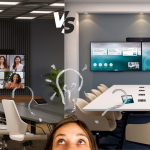Large-scale AV integration for large enterprises comes with big promises: high-quality video calls, smooth presentations and efficient collaboration. Yet ironically, the biggest frustrations often have nothing to do with cables or projectors. In fact, user experience research suggests the vast majority of issues encountered are usability problems, not true hardware failures. In this post we’ll reveal why up to 80% of reported AV issues stem from usability glitches—not broken hardware—and what you can do about it.
The AV Problem No One Talks About
Many IT teams hear a meeting glitch and assume it’s a hardware problem. But data tells a different story: often, the culprit is user confusion or poor design. Common AV issues in boardrooms include:
- Confusing interfaces: Hidden menus and unlabeled buttons that frustrate presenters.
- Connector chaos: Staff bringing the wrong HDMI or VGA cables and adapters.
- Inconsistent systems: Every conference room has different gear and workflows.
- Lack of guidance: No quick-start instructions or training for users.
Recognizing these pitfalls is the first step toward solving them. In practice, that means learning how to fix usability issues in AV systems—by focusing on user-centered design, standardization and training instead of simply replacing hardware.
Eye-Catching Stat: 80% of Issues Aren’t Hardware Faults
It sounds unbelievable, but in large enterprises roughly 80% of reported AV problems boil down to usability or configuration issues, not defective gear. Just five users can uncover about 85% of a system’s usability problems, which explains why so many glitches escape notice until reported. These problems have real consequences: one survey found that when meeting technology fails, 24% of teams miss deadlines and 12% lose money. The good news is that most issues are preventable. Our AV solutions guide walks through how to diagnose these glitches and quickly fix them, helping teams get back on track with minimal downtime.
Explain the Importance of Usability in AV
When it comes to enterprise technology, user experience is not a luxury—it’s a necessity. Even the best Audio Visual Solution will fail if staff can’t figure out how to use it. Intuitive AV systems mean employees waste less time on setup and more time on real work. Making usability a priority yields clear benefits:
- Productivity gains: Intuitive AV solutions let meetings start quickly instead of being delayed by confusion.
- Lower support load: Easy-to-use AV systems reduce the time IT spends troubleshooting, freeing up resources.
- User satisfaction: One study found 88% of people avoid a product after a single bad experience, so a smooth AV interface keeps teams happier.
- Consistency: Standardized controls and workflows ensure users aren’t relearning a new system in every room.
Addressing usability can involve simple fixes. For example, experts suggest eliminating excess cables by switching to wireless presentation systems (BYOD). These changes may seem minor, but they can turn frustrating meetings into seamless collaborations.
Are 88% of Users Less Likely to Return After a Bad AV Experience?
User experience is more important than ever. In one survey, 88% of internet buyers said they would not return to a site if it had a bad UX. The same is true for conference rooms: one flaky conference call or a baffling controller can make employees avoid the system the next time. For instance, if a sought-after executive struggles to start a video call, they might just hardwire into another room — totally avoiding your AV installation.
By upgrading the training and interface, those individuals are kept engaged. Check out our Best Practices for Conference Room Design blog post or our AV Support Services to see how considerate UX can save meetings.
AV system usage problems in big businesses. Good, intuitive AV planning translates into more meetings starting on time. Even the newest screens and speakers won’t matter if nobody can get the controls working in the first place.
Conclusion
In large enterprises, a smooth AV experience hinges on usability. When AV integration is done right, hardware issues truly become rare. Remember: 80% of the headaches in your boardrooms aren’t broken cables—they’re simply moments of user confusion. By making your AV solutions intuitive and consistent, you’ll save time, money and stress. Ready to improve your AV integration for large enterprises? Explore our AV services or [contact us] today to see how we can transform your meeting rooms.





